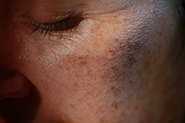
What are free radicals/Reactive Oxygen Species?
Let’s start with quick refresher on free radicals (you might know them as ‘Reactive Oxygen Species’, ROS) and how they damage skin.
Exposure to the sun’s UV radiation, pollutants such as cigarette smoke, and the by-products of our skin’s own day-to-day functioning and cellular aging, result in the generation of ROS. These damage DNA, cellular proteins and structures, stimulating low-level, chronic inflammation throughout our skin. In turn, this accelerates skin ageing and upregulation of the enzymes within skin that degrade collagen.
Our skin uses its own naturally-occurring antioxidants to shut down ROS and limit this damage.
What’s vitamin C, and what does it do for the skin?
Vitamin C, in its bioactive form called L-ascorbic acid (LAA), is the skin’s most abundant natural antioxidant. LAA neutralises damaging ROS so they can’t wreak havoc in the skin. LAA also works to regenerate other antioxidants in the skin’s own arsenal when they are oxidised by UV exposure.
Humans can’t make their own vitamin C, so we must obtain it from our diet (yet another reason that skin health is an inside job – read more about skin health and diet HERE). Several studies have looked at whether oral vitamin C supplements can increase the amount of vitamin C in the skin, but the jury is still out. Luckily topical vitamin C has some solid science around its contribution to skin health.
What are the benefits of a vitamin C serum?
Several human clinical studies and lab-bench experiments show LAA can reduce skin damage from UV exposure when topically applied to the skin. LAA doesn’t act as a UV filter (like sunscreen, which filters UV to prevent skin damage), but instead can reduce UV-induced issues such as redness, signs of sun damage (such as pigmentation and collagen loss), inflammation and immunosuppression, when used in the correct formulation.
Sunscreen alone only prevents around 55% of ROS formation, which is why vitamin C serums are recommended as an extra top up of antioxidant protection under sunscreen in the morning.
Why is the right vitamin C formula important?
Remember that LAA is the bioavailable form of vitamin C that naturally occurs in skin. So it should come as no surprise that the majority of evidence supporting the skin benefits of topical vitamin C, is from studies performed with LAA. These studies also used LAA applied topically in at least a 10% concentration, and at a pH that ensures it can penetrate past the skin surface (
So if LAA is the gold standard of topical vitamin C, why are there so many other vitamin C derivatives populating our shelves? Well, for all its benefits, there are formulating issues with LAA – in aqueous solutions it can oxidise within a few months of opening. But there are also issues with vitamin C derivatives. Yes, they are more shelf-stable, but they also need to be converted to active LAA in the skin, and there is less convincing evidence of their conversion to LAA, skin penetration, and/or antioxidant ability when compared to the body of evidence supporting topical LAA itself.
So if you’re going to use a vitamin C for added antioxidant protection, we recommend SkinCeuticals C E Ferulic. This formulation stabilises 15% LAA at pH 3.2 for optimal skin penetration, and includes other synergistic antioxidants (ferulic acid and vitamin E) that enhance vitamin C’s photoprotective abilities in the skin.
How and when to use a vitamin C serum
LAA isn’t a miracle worker on its own, but is a great addition to any routine focused on future-proofing and sun protection (as every routine should be!). A few drops spread onto on clean, damp skin in the morning under sunscreen is all that’s required.
If you’re already a Qr8 MediSkin patient, reach out to our expert team to see if vitamin C is right for you (especially if you’re new to using prescription skincare).
Want to learn more about how to treat uneven skin tone and brighten skin? CLICK HERE
REFERENCES
Neale R, Williams G, Green A. 2002. Application patterns among participants randomized to daily sunscreen use in a skin cancer prevention trial. Arch Dermatol. 138(10):1319-25.
Young AR, Greenaway J, Harrison GI, et al. 2018. Sub-optimal Application of a High SPF Sunscreen Prevents Epidermal DNA Damage in Vivo. Acta Derm Venereol. 98(9):880-887.
Cosmeceuticals and Cosmetic Practice, 1st Edition. Patricia K. Farris (Ed). 2014. John Wiley & Sons, Ltd. Hoboken, New Jersey.
Antioxidants and the Skin, 2nd edition. Roger L. McMullen. 2019. CRC Press, Taylor & Francis Group. Boca Raton, Florida.
Pinnell SR, Yang HS, Omar M, et al. 2001. Topical L-ascorbic acid: percutaneous absorption studies. Dermatol Surg. 27:127–142.
Murray JC, Burch JA, Streilein RD, et al. 2008. A topical antioxidant solution containing vitamins C and E stabilized by ferulic acid provides protection for human skin against damage caused by ultraviolet irradiation. J Am Acad Dermatol. 59:418-425.
READY TO GET STARTED WITH TREATMENT TO BRIGHTEN AN UNEVEN SKIN TONE?
CLICK HERE TO BOOK A CONSULT WITH OUR EXPERIENCED MEDICAL TEAM.








